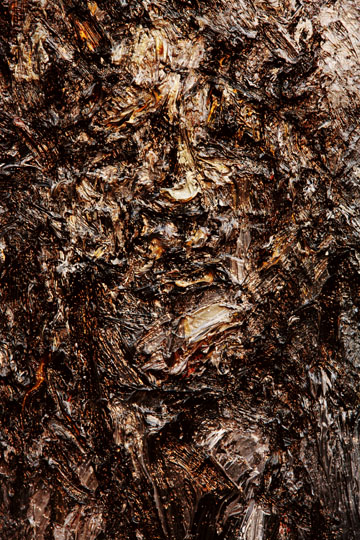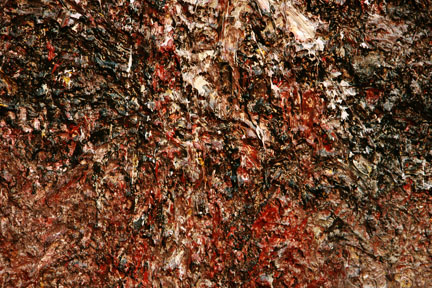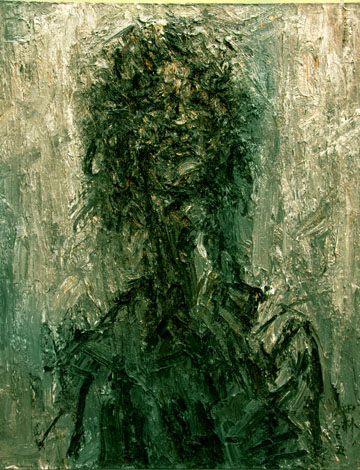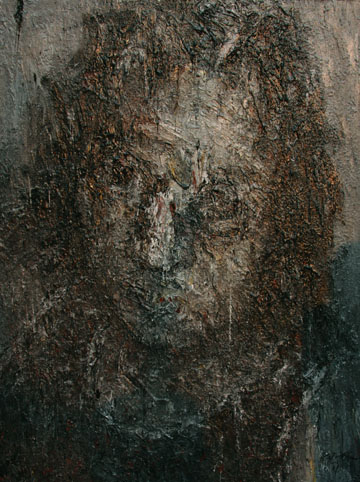The chinese version of the above article will appear shortly
June 23rd, 2008
WELCOME TO THE VIEWING EXPERIENCE欢迎来到观看心旅
January 22nd, 2008
The Viewing Experience is simply a written and pictorial account of the work of artists we meet along the way.
It will be bi-monthly and bi-lingual.
Please find our first post below – in Chinese first and scroll down for English.
Meanwhile, we hope you enjoy reading it and please feel free to comment.
Ash Hempsall & Huang Xiao Kou, Shanghai
欢迎来到观看心旅
这里是中英文博客,您可以在中文的下面搜索到英文。
我们将两个月更新一次用两种语言。
观看之旅这个博客里的文章和图片只不过简单地阐述我们接触过的艺术作品之观看体验,只是非常非常个人的真实感受。当然,如果您有什么不同看法,请自由参与评论。
谢谢阅读我们的观看心旅!
艾希礼 & 黄小扣 上海
无人肖像 ---田林的作品
January 22nd, 2008
我们坐在曾经是法租界别墅的三楼狭窄的工作室里,这里以前一定是一间小卧室。但是这座房子现在已经不能称作房子了,它已经被分成几个小的公寓——也可能是在革命年代里,这个房子被征用,然后又以公共财产的名义重新分配给各个家庭。
房间感觉很像是一条走廊,长度比宽度要长得多。
还未完成或已经废弃的画布占满了房间的整个墙面,看上很象一个个面壁受惩罚的孩子。这间房间的墙纸布满了带着柔和光泽的花卉图案有可能是50年代或者可能是60年代甚至70年代的设计,虽然看上去有点俗气和奇怪,但是给人感觉却很舒服。
正在画的那幅油画悬挂在屋子最远的一端。
这幅油画旁边是一个很大的调色板,几乎所有画家的调色板都非常有意思,他们是油画生命的起源——意味着就像孕育一个孩子;颜料和油就象卵子和精子的结合。你可以看到他们那么迷人那么神秘、不断变化、永远不能依靠自己的力量来完成一幅作品。我们开玩笑说可以用这些颜料做成一本非常漂亮的咖啡桌书。
在田林的调色板里,层层叠叠的颜料已经形成了一个波浪的形状,波峰和波谷处在灰色的海洋里,在这阴暗的海底,还悬挂着水母吐出的彩色汽泡。
我们三人象一个三角形一样坐着,吸着烟,聊天。我们之中只有小扣会说双语。所以抽烟成为我们通用的语言,我们吐出的烟圈圈就象卡通片里的气泡通过空气蜿蜒飘向彼此。
“这系列作品看起来属于人物肖像, 那画的又是谁呢?”
“是的,可以说这些作品属于人物肖像。刚开始是想画某个人,但是我更想尝试去捕捉一种和我当时相似的感觉或者可以说是一种相似的状态。然而,就在我试图捕捉这种感觉把他变成一种绘画风格的时候,我失败了。当失败一次又一次袭来让我变得心灰意冷,最终,当我放弃了通过这幅油画得到我所想得到的时候,也就是说我不想从这幅画中得到任何东西,我对他无所求的时候.,他反而会给你,你所想要的;和作品本身自己所想要的。”
我们停止谈话去观赏他的作品,那些厚重的颜料就象无数的舌头从各个角度想要来舔你。
“这些油画作品就是这样,不是吗?”我说,“ 他们最终回归到画面本身,这些人物肖像作品的画面表达事实上最终要凌驾于这些不知姓名的人物本身。”
“我不觉得这些是人物肖像。”田林回答.
这些具有浓厚颜料的油画作品确实像比喻一样抽象,看似几乎没有什么主题。他们以模糊的形态呈现在你眼前,画面不断的变化,忽而清晰,忽而模糊,就像调色板里的波浪状颜料一样在你眼中起伏不定。
肌理的深度跟油画本身竞相展现出不同的主题,这就要求你从不同的角度去欣赏这幅油画。就好像在曙光下用卫星来观察一些地形,人的形象就好像地上的一个斑点。.在这些作品中我们能隐约感觉到他们正在形成,以非常缓慢的速度继续着。
 他试图带者一种强烈的感情力量保持作画时的姿势打稿,并希望通过这种力量撞击下以同等的比例反馈到他的画面本身。当然,艺术的起源是画家被同样的一种原始力量激励下所产生的。不过他能从岩画中获得灵感并且用如此大胆的方式重塑人物形象,确实让人耳目一新。
他试图带者一种强烈的感情力量保持作画时的姿势打稿,并希望通过这种力量撞击下以同等的比例反馈到他的画面本身。当然,艺术的起源是画家被同样的一种原始力量激励下所产生的。不过他能从岩画中获得灵感并且用如此大胆的方式重塑人物形象,确实让人耳目一新。
从他的画面中你可能可以看到一些脸的轮廓,但是可以辨别不是中国人—-这边是一幅让你感觉是记忆中那种忧郁的、脸部剥落的罗马官员壁画;那边是一张喜洋洋的、却看起来很顽固的骑士。他从艺术史中得到一些启发最主要是那些欧洲的艺术大师,尤其是他们晚年生涯的作品—-比如Titian、Rembrandt、Goya他们晚期的作品。
我们再回到他所塑造的形象,很容易就会把他的作品跟Kossof、Auerbach 或 Giacometti他们的作品联系起来;相反很难把他们跟任何中国的传统艺术或者当代艺术放到一起。不过这样说不公平,首先,如果我们说他摒弃了自己的文化传统,那么,他又如何以道家的学说来诠释自己的作品。其次,他的画法还是跟那些艺术大师的不同。他使用刷子、小刀和手指同时用来作画,从不同的角度在画布上”移动”。看着窗外,下面是公路和人行道,那个不同的”移动”在那里,在交通里,好像他们已经与步行者、摩托车、自行车和汽车之间协商好了似的——人行道变成可以停车,汽车道变成可以散步,就象在芭蕾舞一样从这里跳到那里,从那里跳到这里,从A到B。有人告诉我说那是书法。可以这样说, 当田林作画时,是非常中国的!虽然表面上看起来不是很明显。
当最后一支烟抽完的时候,我们也该走了。我们期待看到田林的作品如何走进下一步,或者更确切地说,接下来的作品如何给他,他想要的;和作品本身自己所想要的。

(translation by Chris Waugh and Izh)
PORTRAITS OF PAINT – the work of Tian Lin
January 21st, 2008
We sit in the narrow studio on the 3rd floor of the old French Concession villa. Once it would have been a minor bedroom in the house. But the house is no longer a house and has been divided up into a coven of tiny apartments – perhaps to the same division now as when it would have been requisitioned and re-allotted as public property to families in the Revolution years.
The room has a corridor feel to it, being so much longer than it is wide.Incomplete or abandoned canvases face the wall the length of the room like punished children . The homey wallpaper is 50’s possibly 60’s even 70’s floral with a satiny sheen and its kitsch is strangely comforting.
The current work in progress takes up the far end.
Next to this painting is a broad palette. Painter’s palettes are interesting things. They are a genesis of process – the zygotic point in the life of paintings; egg and sperm meet as pigment and oil. You could see them as fascinating, ever-changing, never-completed paintings in their own right. A compendium of them would make an excellent coffee table book.
In Tien Ling’s palette, the fat swell of layer upon layer of paint has formed a literal wave shape; crest and trough in a grey sea within whose murky depths hang jellyfish blobs of colour .
We smoke throughout our three-way conversation. Only one of us, Xiao Kou, is able to speak both languages. Cigarettes provide a universal language – as if our smoke exhalations were speech bubbles meandering through the air and drifting into each other.
“The paintings in this series seem to be portraits. Who are they of?”
“Well yes, they probably start out with the intention to be ‘of’ someone. But I’m more seeking to capture the likeness of a feeling or a state of mind. However, in attempting to do that – to capture a certain feeling through style – I fail. Again and again until I become disheartened and, finally, I give up asking for something from the painting altogether. And that’s when the painting gives you what it will”
We pause to look around and the heavy impasto licks at you from all angles.
“That’s the thing about the paintings, isn’t it? They ultimately come back to the medium, the paint. The portraits are even more anonymous for the fact that the representation is physically superceded by the medium.”
“ I don’t really think of them as portraits.”
The most densely painted works are indeed as much abstract as figurative. The subjects are barely there. They stare dimly out at you from the geology of themselves. There’s a constant accession and recession of the image, undulating in the eye like that palette wave.
The depth of texture competes as subject matter in itself, inviting you to view the paintings in different ways. Perhaps as a satellite view of some twilight terrain, the image of Man just a stain within it. Or maybe as a successive line of Dorian Grays – the representation being not so much of the face but of the magnificence of their sin. In the work there’s an underlying sense that the paintings are still forming, growing at fingernail speed.
 (detail)
(detail)
He wants the gestures and marks returned to him with an emotional force and impact commensurate with the physicality of the making. Of course, it’s the same impetus that has driven painters since the beginning of art. But it feels refreshing to see it restated in such a bold way, from the cave wall.
The faces, as can be seen, are not discernibly chinese – over here one is reminded of a morose, flaking official from a Roman mural, over there a beaming, crusted cavalier. The art historical references he makes are mostly to European Old Masters; particularly work from the end of their careers – late-period Titian, Death’s door Rembrandt, last-gasp Goya.
And it would be easy to ascribe greater kinship with Kossoff, Auerbach or Giacometti’s ‘trembling figures’ than with anything traditional or contemporary in Chinese art. But this would be disingenuous. Firstly as it would deny his own cultural heritage, evident from how he talks about process in terms of a Daoist sensibility. Secondly, the way the paint is worked differs. While brush, knife and finger are all employed, the ‘movement’ in the painting really is from a different place. 
Looking out of the window, at the road and pavement below, that difference of movement is right there, there in the traffic. The negotiation and re-negotiation between pedestrian, moped, bike and car – sidewalk turned into truck stop, highway into promenade. The ballet of A to B. (It’s been described to me as calligraphic.)
Likewise, when Tian Lin paints, it comes from a distinctly chinese nature even if not immediately apparent.
As the last of the cigarettes sends up a final whisp of comment so it becomes time to go. We look forward to seeing how Tian Lin develops this work. Or rather, how next the painting will give what it will.
Shanghai, January 2008
